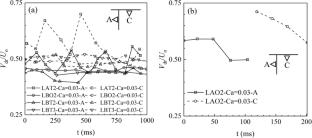Characteristics of the travelling speed of droplet flow splitting in bifurcated minichannel networks
Abstract
The splitting modes of droplet flow in bifurcated minichannel networks are valuable for distributing them in various microfluidics chemical applications and have been widely studied. Previously, predictions of the splitting modes relied on the models of hydraulic flow resistance. This paper presents an experimental study on the correlation between droplet splitting modes and droplet travelling speed characteristics in various minichannel networks. A high-speed camera and machine vision algorithm were used to measure the instantaneous travelling speed of droplets at the inlet and arms of the networks. Five typical splitting modes are identified: bypass splitting, breakup splitting, random splitting, uniform splitting and oscillating splitting. The characteristics of the droplet speed corresponding to different splitting modes are studied and understood by analyzing their varying features and correlations. The results show that splitting modes can be correlated to droplet travelling speed characteristics. This research focuses on how to identify and monitor droplet splitting modes at T-junctions, which relies solely on local visual features of several droplets. It lays the foundation for regulating different splitting modes in the future.


 求助内容:
求助内容: 应助结果提醒方式:
应助结果提醒方式:


